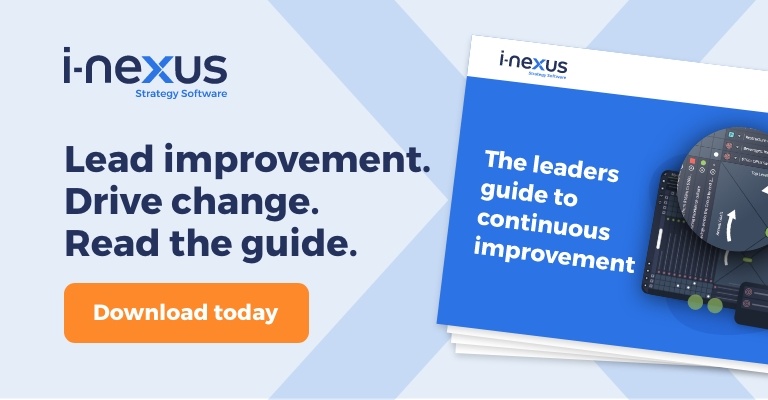Your guide to the many names, terms, acronyms and phrases used when talking about delivering process improvement.
Written by: James Milsom, Head of Marketing
As we speak to leaders and managers in operational excellence roles, we find that one recurring challenge in their improvement efforts is that they want to drive more sustainable ROI from their projects.
Standardization is at the root of the issue preventing teams from supporting their leaders in achieving this. That means a common understanding and approach to improvement methodology in their business.
This begins with language. That's why we've put together this jargon buster with over 50 terms used in the world of operational excellence, business process management, continuous improvement, and beyond.
3Ms, 5 whys, and 7 wastes
3Cs
Three questions to correct a problem - concern, cause, and countermeasure.
3Ms
The 3Ms originate from Toyota's approach to improvement.
They stand for Muda (waste), Mura (overburden), and Muri (un-eveness).
These must be minimized and eliminated for better flow (and thus better customer experience).
5Ss
The 5Ss support a continuous improvement culture, embedding the method into the business. They cover:
- Sort
- Set In Order
- Shine
- Standardize, and
- Sustain
5 whys
The 5 whys involves asking five times why a problem/defect happens until you find the root cause.
7 wastes
The 7 Wastes must be reduced to the minimum in your process, covering:
- Transport
- Inventory
- Motion
- Waiting
- Over-processing
- Over-production, and
- Defects
7 tools of quality control
A set of data collection and analysis tools:
- Check sheets
- Cause and effect diagrams
- Pareto charts
- Histograms
- Graphs
- Scatter diagrams, and
- Broken line graphs
80 / 20 rule
Meaning that 80% of outcomes originate from 20% of inputs.
A3, affinity diagrams, and average charts
A3
An A3 piece of paper upon which current and future state value stream maps are drawn - a highly effective tool for process management.
Abnormality management
A core part of eliminating waste, abnormalities must be easily visible in a process to promote swift action. This becomes part of your standard work.
Accuracy
Instrument accuracy means the difference between a recorded average value in a test and the master value for the same test.
Agile
A time-defined, iterative approach to software delivery that builds software incrementally from the start of the project. Closely linked with sprints, kanban boards, etc.
Affinity diagram
A means to organize data and ideas relating to your process.
Andon
Giving attention to defects/abnormalities of a process flow. The Andon stops the process until root causes are identified.
Andon Board
A board that empowers you to see the status of a production system and highlight emerging issues/abnormalities.
ANOG
An analysis technique to organize data from best to worst and identify visual trends (Analysis of Good).
ANOM
Like ANOVA, it only addresses the difference of means (Analysis of Means).
ANOVA
A statistical technique to analyze data by dividing the total variation of data into meaningful parts associated with specific sources of variation to test a hypothesis or estimate variance components (Analysis of Variance).
Attribute data
One of two values, e.g., yes or no, green or red.
Average chart
A control chart where the subgroup average, X-bar, helps evaluate a process level's stability.
Balanced scorecard, BPM, and bottlenecks
Barriers to flow
Process steps preventing flow, such as approvals or set-up time.
Balanced scorecard
A means to translate your strategic plan into metrics focused on different perspectives - finance, customers, process, and learning.
Baseline
A measure of how your process works now.
Benchmarking
A means to compare performance, such as year-on-year or best results.
Business process management (BPM)
A comprehensive approach to improving flow, streamlining, and aligning the process to your customers' needs.
Bottleneck
Something that blocks your process' flow and impacts the process' smooth completion.
Brainstorming
A group approach to creating new ideas / problem-solving.
Breakthrough objectives
In strategy deployment a change in the existing processes and performance of an organization.
Cause and effect diagrams, control charts, and cycle time
Categorical data
Data grouped into categories.
Cause and effect diagram
A problem-solving tool used to form relationships between effects and causes. The effect is revealed via branches (fishbones) showing different causes of it.
Cause and effect matrix
A tool for analyzing a process by ranking the impact on the customer and the likelihood of occurrence. This usually precedes an FMEA.
Common cause variation
Causes of variation that are inherent in a process over time.
Continuous data
Data of any value, e.g., width.
Continuous improvement
Increasing business effectiveness by reducing inefficiencies, frustrations, and waste (time, effort, material, etc.).
Control charts (Shewhart charts)
A chart that shows if a process is in control.
COPQ
What is the cost of failing to meet a customer's expectations? Covering views such as internal, external, inspection, prevention, and missed opportunities (Cost of Poor Quality).
Core competencies
What an organization, individual, or team does best.
Countermeasure
The actions taken to address the root causes of problems that prevent you from achieving your goals.
Culture
Your business' character comprises its values, vision, routines, symbols, and structures.
Current state (current state map)
The current state value stream map shows the current process' flow of information and identifies opportunities for improvement.
CTQ
What your customers consider critical to quality.
Cycle Time
The time required to complete one cycle of an operation.
Daily management, DMAIC, and drift
Daily Management
Giving daily attention to issues that occur within business as usual.
Deming cycle
Plan, Do, Check, Act:
- Plan: Define your goals and map out how you’ll achieve them
- Do: Implement your plan
- Check: Assess the results of your plan and understand any improvements that can be made
- Act: Adjust based on your findings from ‘Check’
DMAIC
One of the main concepts of Six Sigma methodology can also be found in Lean. This covers:
- Define
- Measure
- Analyze
- Improve, and
- Control
DOE
Statistically planned experiment based on the FMEA and process map (Design Of Experiment).
DPMO
A measure of the potential for a defect in a process (Defects per Million Opportunities).
DPU
When a customer requirement isn't met, it can also be known as escapes (Defects per Unit).
Drift
A process, measurement, or statistic's natural shift over time.
Failure modes, flow, and future state
Factors
Independent and controllable variables that can change the output of a process used in DOE.
Failure demand
Work that fails to meet customers' needs.
First in, first out (FIFO)
Items removed/processed in the same order received.
Flow
The state of a process in which the parts move from one step to the other in a steady, continuous stream without reducing quality.
FMEA
Failure Modes and Effects Analysis – a method for documenting potential failure modes, determining effects, identifying causes of failures, developing a plan, agreeing on action, and then taking said action.
It can be completed using an Excel template.
Future state
The new set of conditions will improve the process and information flow.
Gemba, Hoshin Kanri and jidoka
Gemba
Going to where value is created.
Genchi Genbutsu
Visiting the area in the production where there is an issue.
Hansei
Reflection on the past and moving forward with its learnings.
Heijunka
A production process to prevent overstocking, reduce cost, maximize work energy, and optimize lead time in a value stream.
Hoshin Kanri
Hoshin Kanri – sometimes known as Hoshin Planning, Policy, Goal, or Strategy Deployment – is a strategic planning process whereby strategic goals are communicated and translated into action.
Originating in Japan in the 1950s and now being adopted worldwide as the de facto Strategy Execution methodology, Hoshin Kanri means “policy management” in Japanese.
The characters use elements of ‘compass’ and ‘direction’, with the obvious implication that you need to know where you are going and a map to get there.
Huddles
Short, regular meetings to share key information and agree on action plans.
Inventory waste
Underutilized resource.
Ishikawa (Fishbone) diagram
A structured way to brainstorm and capture cause and effect, also known as Fishbone due to its shape.
Jidoka
Process automation with human intervention only in times of defect.
Kaizen events, KPI, and Lean
Kaizen
A Japanese philosophy that sees improvement in productivity and customer experience as a gradual and methodical process.
Kaizen Event
A short structured problem-solving event where 100% of the time is spent identifying how to improve a process.
Kanban
A method of pulling work through a system so the downstream process signals the upstream process to replace what has been used.
Kamishibai board
A board with red cards showing outstanding tasks, due date, and owner. This turns green when completed.
Katas
Katas bring to life small routines through practice, as opposed to learning by memorizing. These are crucial to the Toyota Production System.
The Kata protocol ensures that knowledge and best practice can be transferred to your organization.
Two Katas are fundamental to Toyota’s improvement culture:
- Problem-solving: Here, the focus is on one issue or improvement priority at a time, with the swiftness of problem-solving at the core of the Kata
- Coaching: Improvement is fundamentally bottom-up, achieved through leaders offering guidance on how to resolve problems in the best way
Katas are important for business leaders regarding continual improvement as they are ingredients for a culture of growth and learning.
Kipling
A method to understanding problems by asking:
- What?
- Where?
- Why?
- When?
- Who?
KPI
Business critical values which measure progress towards strategic goals.
Lead time
The total processing time from order to delivery
Lean
The striving to avoid waste, boost quality, and drive continuous improvement in all processes.
Lean Six Sigma
The Lean Six Sigma method uses cross-team effort to improve performance by systematically removing waste and reducing variation, combining the two approaches of Lean and Six Sigma.
OODA, PDCA, and poka yoke
OODA loop
Observe, orient, decide, act.
PDCA
See Deming Cycle.
PACE chart
A tool categorizing ease of implementation and anticipated benefits. PACE means:
- Possible
- Action
- Challenge, and
- Eliminate.
Pareto Chart
A chart containing bars of individual values, organized in descending order to show the few but important issues to address. It follows the 80 - 20 rule.
Performance Board
A workplace board showing performance.
Poka-yoke
A system to prevent errors.
Process
A series of actions that produce something or create a particular result.
Process flow
The sequence and interactions of process steps that make up an individual process, from beginning to end.
Process mapping
A tool to visually demonstrate the steps and decisions in a process to understand the process clearly.
Project charter
A document created at the beginning and used throughout a project/event to provide focus and goals for a project.
Pull system
A system focused on producing only what has been consumed by downstream activities or customers, minimizing waiting, over-production, and inventory waste.
Push system
In contrast to the pull system, a product is pushed into a process regardless of its need.
Qualitative data, SIPOC, and standard work
Qualitative data
Descriptive information.
Quantitative data
Numerical information.
Quality function deployment (QFD)
A matrix plots and ranks product/service features to understand what is critical to the customer.
Quality management
The systems, organizations, and tools make planning, executing, and tracking a quality product or service possible. Here quality is built into the system.
RASIC or RASI
A means to evaluate processes and people involved by different categories:
- Responsible,
- Accountable,
- Supportive,
- Informed, and
- Consulted.
Root causes
The core reason for an issue with a process.
You can conduct a root cause analysis using Excel templates such as these.
Scorecard
A metrics collection is categorized using a traffic light system (TLS) or RAG system (red, yellow, and green) based indicators.
Single Minute Exchange of Dies (SMED)
Completing a changeover in less than 10 minutes can be achieved through a standardizing process.
SIPOC
SIPOC is a tool to summarize the inputs and outputs of processes. It covers:
- Suppliers
- Inputs
- Process
- Outputs, and
- Customers
Six Sigma
Management techniques to improve processes by reducing the likelihood of errors/defects. It’s directly connected to the DMAIC system.
SMART Goals
SMART goals are an effective way to create meaningful targets, meaning the goal should be:
- Specific
- Measurable
- Achievable
- Relevant, and
- Time-bound
Sprint
An agile term for working chunks of 2 weeks with a defined amount of work.
Sprint planning
An agile team meeting to identify the work that will be completed during a sprint.
Stakeholder mapping
Map stakeholders, their level of interest and influence in your work, and how you should best manage them
This can be completed using templates such as this. We recommend reading our guide on applying the AIM CAST framework to bolster your mapping.
Standard deviation
A measure tells you the variation in a process.
Standard work
An optimum use of people, machines (mechanical resources), and materials for a process.
Standard work in the process
The minimum amount of material needed in a process for proper flow.
Standardization
Standardization means documenting the best way to complete your process, ensuring reduced variation and a more consistent customer experience.
Statistical process control
Monitoring performance outputs over time to monitor if output is in control.
Supply chain
All the end-to-end stakeholders in your product/service.
Takt time, VOC and yokoten
Takt Time
The average amount of time between the beginning of one activity and the start of the next, meaning rhythm in German.
TIM WOOD
An acronym covering the seven wastes:
- Transportation
- Inventory
- Motion
- Waiting
- Over-production
- Over-processing, and
- Defects.
Toyota Manufacturing System (TPS)
The majority of Lean principles emerged from the TPS.
Value
All your customer is willing to pay for.
Value stream map
A process map that captures information, process flow, and performance data.
Vision
Where you want your organization to be and how you will get there.
Visual management
The display of information so it is visible and understandable at a glance.
Voice of the customer
The "Voice of the Customer" is the term used to describe the stated and unstated needs or requirements of the customer.
This can be documented by:
- Interviews
- Surveys
- Focus groups
- Customer specifications
- Observation
- Warranty data
- Field reports
- Complaint logs
- Customer service tickets
- Social media
Yokoten
The Japanese phrase for horizontally deploying learnings/methods. This is a perfect term to capture the power of continuous improvement. It's all about identifying issues, using a process, sharing results, and then applying this elsewhere to create a larger impact on the business.
Continue learning about continuous improvement.
Click here to learn more about continuous improvement, or take a look at these content recommendations:
- Continuous improvement in 2020 and beyond: Watch how continuous improvement will evolve into the 2020s and how you can be successful.
- DMAIC v Six Sigma v Lean: Our guide to the steps and tools you'll need when driving process improvement through one of these three methodologies.
- The Leader's Guide to Continuous Improvement: Download this eBook to get a comprehensive overview of how DMAIC, Six Sigma, Lean, and PDCA can support your business in finding a competitive advantage.
About the author
James Milsom is Head of Marketing at i-nexus. As Head of Marketing, his drive is to raise awareness and understanding of the challenges facing enterprises in delivering strategic objectives and transformation amidst changing markets and the obstacles traditional tools and methods present leaders.
If you’d like to talk more about strategy, reach out to James on james.milsom@i-nexus.com or connect with him on LinkedIn for the latest insights.









